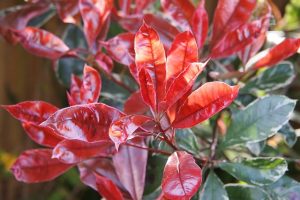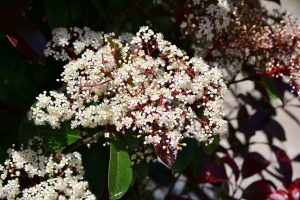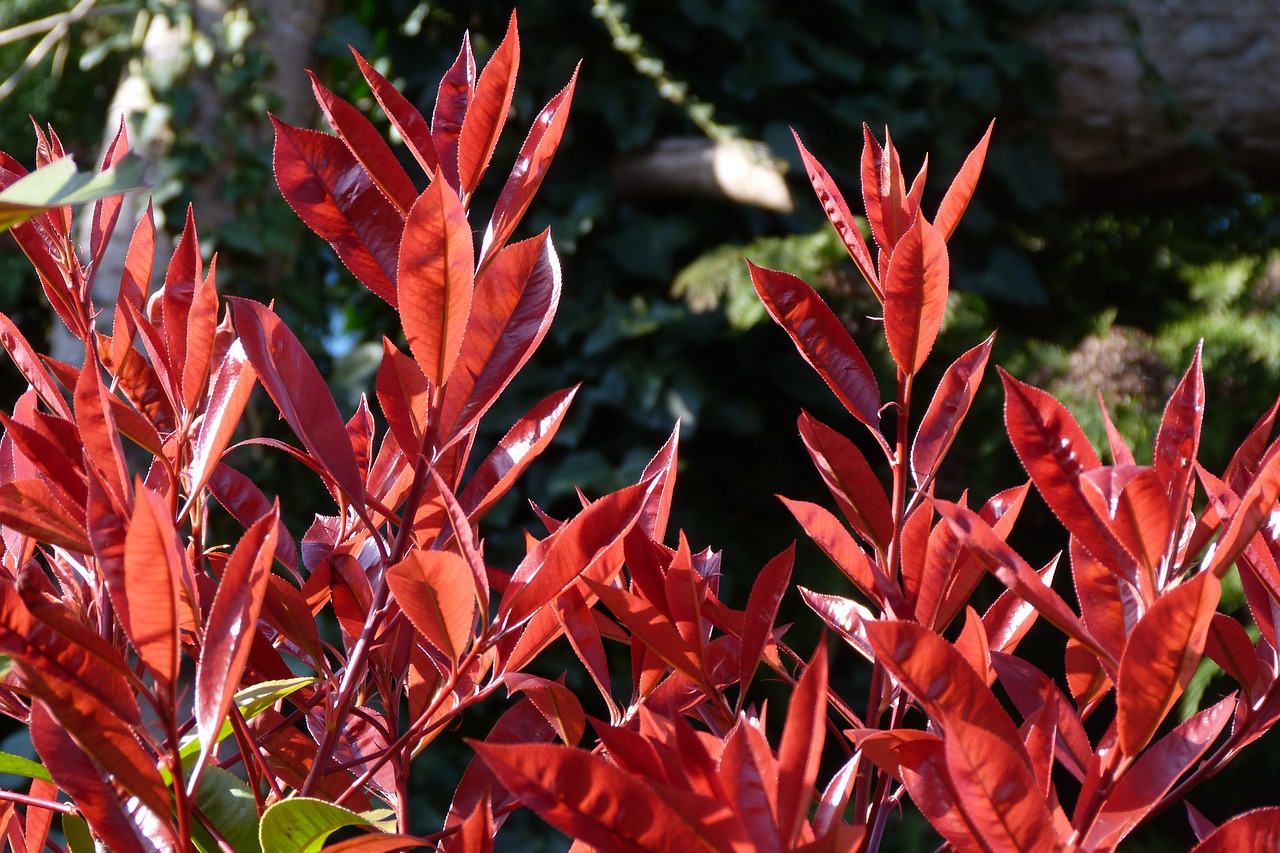Last Updated on February 15, 2022 by Real Men Sow
The Red Robin also called Photinias, are native to North America and Asia. Before growing Photinia ‘Red Robin’, this evergreen shrub, make sure you keep the following as a guide to see if it would suit growing in your garden and if you want to grow them:
What To Consider Before Growing Photinia ‘Red Robin’
- If you don’t have time to prune them, they’ll reach a height of 13ft and spread 13ft as well. When you do have the time to prune them, don’t worry, they respond well to pruning. They can be kept at 4ft if you’re pruning them
- The plant is hardy, and can tolerate temperatures up to -12°C
- They have red leaf tips that turn green once they mature. If you leave them unpruned, they grow attractive tiny white flowers that, unfortunately, do not smell good
- They thrive in deep loam type soil, but could still tolerate other soil types except heavy clay or waterlogged soil
- Thrives in full sun but does well in partial shade, however, make sure to avoid full shade
- Tolerates moderate drought and rarely requires watering once it’s established
- The plant is not poisonous to dogs, but can graze animals like horses and cows.

Steps To Growing Photinia ‘Red Robin’
Step 1: Choose a position that is full sun or part shade. It needs air circulation to thrive so it should not be planted in the corners of fences or walls.
Step 2: Add lots of compost to heavy soils and make sure it drains well.
Step 3: You can plant it all year long as long as the soil isn’t frozen and that you water well when it gets dry. This shrub is best planted between March and April and September through October.
Step 4: Dig a hole twice as wide as the root ball. Sprinkle organic fertiliser and work into the ground
Step 5: Fill the hole with soil to the same depth as the pot. Firmly but gently fill the hole around the root ball. To settle the soil around the root ball, water well.
Growing Red Robin as a Hedging Plant
The plant can be grown as a hedge. Individual plants should measure 75cm (2ft 6in). This will allow for a dense, fast-growing hedge. The plants should not be planted against a fence or wall and should be no more than 60cm (2ft) away from it.
They may not get enough moisture if they are planted too close to the roots. This is because walls and fences won’t receive as much rain as the base of the plants. Remember that Red Robin hedges won’t be dense or prevent intruders.
 Taking Care of Red Robin
Taking Care of Red Robin
A Photinia Red Robin will take care of itself once it is established. It doesn’t require water except in extreme drought, and can grow happily on any average soil without additional feeds. It will require pruning once or twice per year to maintain its shape and size.
Water younger plants (up to 2 years old) if the conditions are dry. It will establish a strong root system by receiving a twice-yearly feed of blood, fish, and bone in spring or autumn. The area surrounding the base of your plant should be free from grass and weeds.
Red Robins are known to drop leaves throughout the year. This can be a problem for gardeners who love to tidy up their gardens. The ideal place for snails and slugs is where the leaves have fallen to the ground.
Pruning Red Robin
The shape and size of the plant will determine how often you prune it. Red Robin can grow happily without pruning and will eventually reach a height of 4m/13ft after seven years.
If you prefer a smaller shrub, then you can prune between March and mid-July. Pruning should not be done after July as the young shoots that emerge after pruning can easily be damaged by frosts. Remember that these shrubs should not be pruned until they are 3 years or older.
The best time to prune flowers is in June, between early and mid-June. You are more likely to have flowers next year if you prune this time of the year.
Individual stems should be pruned just above the leaf node, there are no special techniques required.
They can be cut very hard and they grow new shoots. A plant that is out of control can be cut down to 60 cm in height. This type of pruning should be done in May when the plant is strong.
Red Robins Grown in Containers
One Red Robin can thrive in a large container. A 45cm diameter or greater is ideal. Fill it with standard multi-purpose compost.
It should be fed once a month, between mid-March and mid-August. Regular watering is necessary only after waiting for the top 3cm of compost to dry, and water it well.
Prune them the same way non-container-grown red robins are pruned, but it is best to prune more often to maintain a healthy plant and a suitable size container. To avoid the shrub being easily blown over, it is a good idea to place it in a sturdy container.
Photinia Red Robin Problems
Red Robins are healthy plants that are rarely attacked by pests. Its only weakness are the leaf spots and honey fungus..
Leaf Spot
This problem is characterized by dark red/black spots on the leaves. The affected leaves eventually fall off, and worse cases can cause severe damage to the plant. Damp, humid, and/or cold conditions are the culprits of this problem.
If the damage is not severe enough, you can remove the spotted leaves and then burn them.
There are two options for severe damage:
- In May, prune the plants hard. Once the prunings are removed, the plant should bounce back in about a month with new red growth.
- Accept the fact that the plant’s position is the problem. Dig it up and plant something better. It is possible to make cuttings. Please refer to our section on propagation.
Honey Fungus
This fungal disease spreads underground, from one plant to another. It causes the root system to become ineffective at absorbing nutrients and moisture. A generally unhealthy plant will have white fungus near the ground on its stems. The white material will be easier to see if you get under the soil.
Your Photinia won’t be the only one affected, but Photinias are especially susceptible. This disease is very difficult to eradicate. The only way to eliminate this disease is to cut down and burn the affected trees and to plant the ones that are resistant to honey fungus.
Red Robin Propagation
Red Robins are easy-to-produce and have high success rates, even for amateur gardeners. These guidelines will help you achieve the best result:
- The cuttings should be taken between late July and early September. To prevent moisture loss, store the cuttings in a plastic bag. Make sure to take the cutting for longer than necessary.
- To make a cutting of 8cm/3in, choose a stem that is approximately 2mm thick. Semi-ripe means that the cutting is not made from new soft growth or old growth. The best cut is somewhere in the middle.
- Take out the lower leaves
- Place three evenly spaced cuttings into a 8cm-wide pot of multi-purpose.
- To ensure that the compost is in contact with the stem, gently press the compost around the cuttings. To ensure maximum success, you may need to take six cuttings. Two pots are better.
- The pot should be placed in a shallow tray or bowl of water for at least half an hour to absorb water. However, the top of the pot should not become waterlogged.
- Remove the pot from the water, then cover it with cling wrap or a small plastic bag. Support it so it doesn’t touch the leaves. This is a good way to use plant markers.
- Place the pot in a cool, shaded place.
After two to three weeks, the cuttings should be able to root. At this point, you can remove the plastic bag and place them in the final position.
Keep the rooted cuttings out of direct sunlight and in a cold greenhouse. You may need to water them. Keep the compost moist, but not waterlogged.


